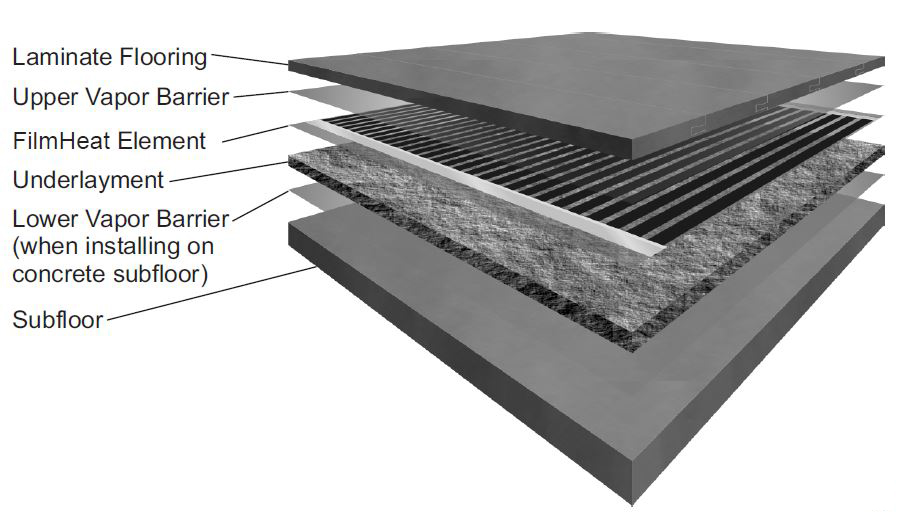
Contact Warmzone today.

Contact Warmzone today.

Contact Warmzone today.
Nothing can beat the convenience and efficiency of an automated radiant snow melting system. Waking up to a clear driveway after a snowy night can start your winter day off on the right foot. Instead of reaching for your snow shovel and gloves, you can grab your slippers and coffee mug. Automated snow melting systems reliably operate as needed, so you can be assured that regardless of the storm conditions, the system will keep your driveway or walks free of snow and ice 24/7.
Automatic radiant heat systems rely on rugged, high-tech activation devices (sensors) that detect precipitation and temperature. Two basic types of activation devices can be used: in-ground (pavement-mounted) sensors and aerial-mounted sensors. The in-ground sensor is installed in the surface of the area being heated, such as the driveway or parking apron itself. These rugged sensors are typically used for large, commercial snow melting applications, and installed where they are open to the elements. Aerial-mount sensors are typically used for residential snow melting systems such as heated driveways, sidewalks, steps, etc. The aerial sensor is mounted near the roofline, extending out where it is exposed to the weather.
When precipitation is detected, and the temperature is below the adjustable setpoint (typically set at 39°F), the sensor will send a signal to the controller. (The controller is usually mounted on a wall in the garage.) Upon receiving the signal from the snow sensor, the controller then sends power to the embedded heating element.

Warmzone’s energy-efficient snow melting systems feature the renowned ClearZone™ heat resistance cable. The versatile ClearZone heating element can be installed in a variety of applications, including concrete, asphalt, and stone pavers. The cable is available in various lengths off the spool, as well as in mats that can be rolled out for quick and easy installation.
After almost two decades of performing in a variety of snow melting applications throughout Northern America, ClearZone heat cable has built a reputation as a trusted industry-leader. The proven cable is made with superior workmanship and materials. The twin-conductor ClearZone cable is cCSAus listed, and designed with fluoropolymer insulation and polyolefin jacketing (for flexibility and UV protection), which allows the snow melting system to consistently provide top performance during harsh winter conditions. The heat cable comes with a 20-foot cold lead, and carries a 10-year manufacturer warranty.
Warmzone Continues to Update its Line of Radiant Heat Products
Warmzone snow melting system sensors (activation devices) and contactor panels (control devices) feature the latest proven technology, and are designed for durability and robust performance throughout the years. Warmzone constantly researches, develops, and tests the most advanced technology. The latest addition to Warmzone’s product line is the EcoTrace IC thermostat (controller). This IoT (Internet of Things) thermostat uses proprietary algorithms to process weather data and adjust the snow melting system’s power output according to storm conditions.
“IoT” refers to the Internet of Things, and is an important new technology that allows us to embed sensors in objects around our homes that can then be connected to the internet. The embedded sensors allow us to measure environmental parameters, and the data is then transmitted through a communications network. This way we can connect to our home lights, the hot tub, the heated driveway, etc., which makes seamless communication possible between people, processes, and things.
The EcoTrace IC Thermostat’s “smart” capability also allows the radiant heat system to ignore light storms, provide optional preheating, and the ability for dynamic heating after the storm, all to improve overall system performance and reduce energy use and operating cost. The user is able to choose from a selection of weather-based control algorithms, for heated driveways, roof de-icing, and gutter heat tracing systems.
Warmzone snow melting system sensors (activation devices) and contactor panels feature the latest proven technology, and are design for durability and robust performance through the years. A wide selection of options is available. To learn more about automated snow melting system controls, call and speak with a radiant heat expert, at 888-488-9276.
In addition to automated snow melting systems, Warmzone also provides premier floor heating and roof de-icing solutions, as well as luxury home heating amenities. For more information about Warmzone radiant heat systems or luxury amenities, contact a friendly Warmzone representative today, at 888-488-9276.
###

Contact Warmzone today.

Contact Warmzone today.

Contact Warmzone today.

Contact Warmzone today.

Contact Warmzone today.

Contact Warmzone today.
Warmzone® offers one of the largest selections of radiant floor heating products in the business. Carrying a wide variety ensures that customers receive the best system for their specific floor types, budget, and heating needs. One popular floor heating system is Warmzone’s FilmHeat™ radiant heat system.
Designed for installation under laminate and floating floors, the innovative FilmHeat floor heating system features heating panels that are just .016-inch thick. That’s thinner than a credit card. The paper-thin heating element is so lightweight that it will not affect weight loads, and because it is so thin, installing the system will not cause any floor buildup.
The heating element is applied over an underlayment, and the floating floor is then installed. There is no need for mortar or self-leveling compounds, alarms, or special tools. This remarkable system is quickly and easily installed, and the heating mats come with the cold leads attached.

The FilmHeat floating floor heating system consists of three major components: the heating elements, the wiring, the control device. These components work together to create a system that provides comfortable, energy-efficient floor warming as either a primary heating system, or as a supplement to the existing home heating system. FilmHeat can be installed on any standard, flat sub-floor, but care must be taken that the subfloor is smooth and free from protrusions such as nails or screws that may damage the heating element.
Features and Benefits
Heat Existing Floors with RetroHeat®
A variation of the FilmHeat system (called RetroHeat) is also available to heat existing floors. If you have access to your floors joists from below, either through a crawl space or basement, you can enjoy the comfort of radiant heat, without having to replace your current floor or undertake any major remodeling.

The UL listed RetroHeat panels are stapled up between the joists, and then batt insulation is then applied to direct all of the upwards to warm the floor. The RetroHeat system provides comfortable warmth for a wide variety of floor types, and is extremely efficient, with virtually no heat loss. The heating elements provide 10 watts per square foot, and can be cut onsite.
Thin, flexible, ultra-efficient FilmHeat and RetroHeat floor heating systems are engineered to deliver the ultimate in thermal comfort. The heating panels can be used to warm a variety of floor types, with low energy consumption at affordable prices. These systems are commonly used to complement the existing home heating system by providing extra comfort to the most popular rooms in the house. The systems are configured with factory connections, and all products are suitable for either new construction or renovation projects.
For more details about the many radiant floor heating options that are available, contact Warmzone today, at 888-488-9276.
Warmzone is one of the largest providers of floor heating, snow melting, and roof de-icing systems, as well as luxury home heating amenities. For more information about Warmzone radiant heat systems or luxury amenities, contact a friendly Warmzone representative today, at 888-488-9276.